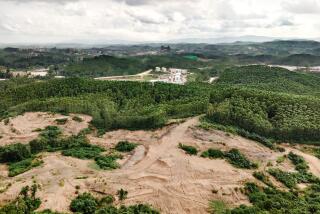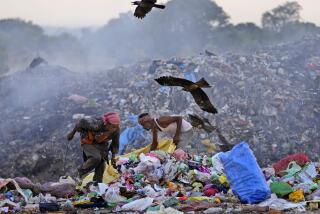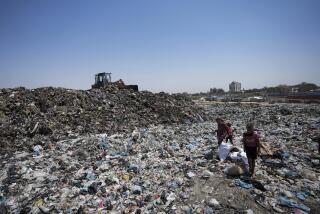In Southeast Asian Capitals, Sanitation Becomes Dirty Word
MANILA â Southeast Asiaâs mega-cities are drowning in a sea of trash. Beset by a shortage of funds and antiquated waste disposal systems, they are watching with a sense of helpless alarm as dump sites fill up and overflow, rivers and bays become polluted, alleyways get clogged with rubbish.
âCrisis? Yes, we have a crisis,â said Lito Atiemza, the mayor of Manila. âBut at least the whole nation knows we have to get a modern waste system in place. The technology is there. We donât even have to be innovative. We just need the funds.â
The crisis was spawned by a regional economic boom in the 1980s and early â90s that brought waves of rural migrants to the cities in search of opportunity and sent the populations of metropolitan Manila; Bangkok, Thailand; and Jakarta, Indonesia, soaring past 10 million each. Left in the dust were municipal services, and the cities soon realized that they had more waste than they knew how to handle.
Manilaâs 600 city trucks, augmented by a fleet of privately contracted vehicles, haul away 5,600 metric tons of garbage a day to a landfill in the nearby town of San Mateo that has grown to the height of a nine-story building. Still, 30% of the cityâs trash ends up in waterways or vacant lots. Atiemza estimates that it would cost up to $200 million to put a proper waste system in place.
Crispin Santos, the mayor of San Mateo, says Manilaâs garbage is smelling up his town and causing health problems. In January, in one of the few environmental demonstrations the Philippines has ever seen, Santos led protesters who formed a human blockade and prevented garbage trucks from entering the dump for six days.
âI donât care what Manila does with its garbage, just as long as it doesnât dump the stuff here,â Santos said. San Mateo has sued Manila in an effort to close down the capitalâs only dump site.
Manila also has a problem with its sewage. Refuse is fed untreated into Manila Bay through a single, 6-foot-diameter pipe. The waste pours into the harbor just across the street from Manilaâs most popular seafood restaurant, the Aristocrat, leading Sen. Loren Legarda to observe, âManila is facing a crisis of nightmarish proportions.â Among the repercussions: The capitalâs tap water is no longer potable, and bottled water is in such demand that a quart of it costs more than a quart of gasoline.
Another of Southeast Asiaâs mega-cities, Jakarta, deals with its rubbish problem by more or less ignoring it, even though the Indonesian capital initiated an anti-litter program 27 years ago. So much trash clogs Jakartaâs rivers that city officials say the danger of flooding has increased substantially.
Of the 450 landfill dumping areas in Jakarta, only six are controlled by sanitation authorities. The others are just pits into which trash is thrown. The main strategy for disposing of waste is to burn it, and the national Department of Environment believes that the haze hanging over Jakarta much of the time is caused not by factories or exhaust fumes but by the hundreds of piles of garbage smoldering throughout the city.
âI havenât even noticed the haze--thatâs how busy I am,â said Mohammed Anwar, 30, one of scores of professional scavengers who earn a good living at Bantar Gebang, Jakartaâs principal dump site. Even after giving the gatekeeper 30% of his profit to gain entry to the dump, he often takes home $3 a day, considerably more, he says, than he could make in a factory.
Like his colleagues, Anwar is a sort of human recycling plant, poking through huge piles of trash to collect anything that can be recycled and sold. The recent fall of the rupiah, the Indonesian currency, against the U.S. dollar bumped up the price of recycled plastic, and Anwar says business is so good now that the established scavengers have to fight off newcomers trying to carve out their own turf at the dump sites.
Although Jakarta makes an attempt to collect garbage house to house, the service is not free and is ignored by the cityâs huge class of urban poor. Jakarta officials estimate that more than 2 tons of garbage is thrown into the cityâs waterways daily.
Bangkok was once known as the âVenice of the Eastâ because of canals that served as the cityâs transportation lifeline and were an important source of fish. Today, the canals are swamped with garbage, and most of the fish are dead.
The cityâs sanitation budget is only $5.5 million a year, but Bangkok hopes to get international aid to build two modern incinerators for waste disposal. It has started a campaign to get households to recycle and take other environment-friendly steps. As in other cities in the region that have made similar efforts, the campaign hasnât had much success.
âEven though we can impose a fine for not recycling, people think all these things are the duty of the city and not their responsibility,â said Charlie Sinthunava, director general of Bangkokâs Public Cleansing Department. âWe try to convince them we have to work together on this, but itâs hard changing their habits.â
Even Southeast Asiaâs âsmallâ capitals, such as Hanoi (population 2.5 million), are reaching the crisis point in waste management. The Vietnamese capital discharges most of its household and industrial water directly into the drainage system, which empties into once-pristine lakes and rivers.
âAlmost none of it is managed or processed,â said Luu Minh Tri, deputy chairman of Hanoiâs Peopleâs Committee. No wonder, he adds, that restaurants along the cityâs West Lake no longer serve snails caught in the water there.
Health officials say Vietnamâs 800 hospitals are particularly egregious, with most of their water and 40% of their solid waste disposed of improperly. The Health Ministry said that proper waste treatment facilities at the countryâs hospitals would cost $228 million and that industrial cleanup costs would run into the billions of dollars, stratospheric figures for cash-strapped Vietnam.
The country also is paying a price for skyrocketing consumption trends that have come with the communist governmentâs decision to move toward a free-market system. Since 1993, the trash produced daily in Ho Chi Minh City, formerly Saigon, population 5 million, has surged eightfold, city officials say.
One encouraging note in all this: The regionâs environmental crisis is receiving a lot of attention.
Philippine President Joseph Estrada sent three top aides to Europe last month in search of high-tech waste systems. And among the international donors involved with various regional programs to clean up water supplies and develop waste management facilities are the World Bank, the U.N. Development Program, New Zealand, Germany, Canada, Japan and Spain.
More to Read
Sign up for Essential California
The most important California stories and recommendations in your inbox every morning.
You may occasionally receive promotional content from the Los Angeles Times.










